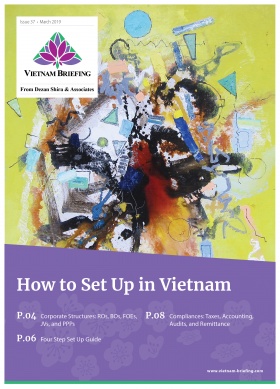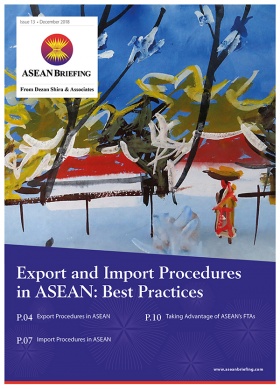Vietnam’s Import and Export Regulations Explained
Once an investor has set up their trading company within Vietnam, it is important that their workers gain a strong understanding of the country’s import and export regulations and procedures.
Below we lay out the key regulations that companies should be aware of before starting their trading activities in Vietnam.
Import and export licensing procedures
Vietnam does not require a company to have an import or export license to set up a trading company. However, to be able to conduct import or export business, a foreign investor must register with the Department of Planning and Investment (DPI).
Additionally, foreign investors who wish to engage in import or export activities in Vietnam are required to obtain an Investment Certificate. Companies that wish to expand their current business operations to engage in import or export activities must follow the procedures for adjusting their Investment Certificates.
According to Circular 34/2013/TT-BCT, there are certain goods that foreign invested enterprises may not export from, or import into, Vietnam. Goods banned for export include petroleum oil. Goods banned from import into the country include cigars, tobacco, petroleum oils, newspapers and journals, and aircraft.
Certain goods require the trading company to obtain import and export permits from the government, as per Appendix II of Decree 187/2013/ND-CP. These include:
- Goods subject to export control in accordance with international treaties to which Vietnam is a contracting party;
- Goods exported within quotas set by foreign countries;
- Goods subject to import control in accordance with international treaties to which Vietnam is a contracting party; and
- Chemicals, explosive pre-substances and industrial explosives.
All imports and exports must comply with the relevant government regulations on quarantine, food safety, and quality standards, and must be inspected by the relevant government agencies before clearing customs.
Importers are also required to submit a customs dossier which includes a customs declaration as per Appendix II of Circular no 38/2015/TT-BTC. The customs declaration can be filed electronically here.
Duties applied to import and exports
Most goods imported or exported across the borders of Vietnam, or which pass between the domestic market and a non-tariff zone, are subject to import/export duties. Exceptions to this include goods in transit, goods exported abroad from a non-tariff zone, goods imported from foreign countries into non-tariff areas for use in non-tariff areas only, and goods passing from one non-tariff zone to another.
Most goods and services being exported are exempt from tax. Export duties (ranging from zero percent to 45 percent and computed on free-on-board (FOB) price) are only charged on a few items, mainly natural resources such as minerals, forest products, and scrap metal.
Consumer goods, especially luxury goods, are subject to high import duties, while machinery, equipment, materials and supplies needed for production, especially those items which are not produced domestically, enjoy lower rates of import duties, or even a zero percent tax rate.
Duty rates for imported goods include preferential rates, special preferential rates, and standard rates depending on the origin of the goods.
Import/export duties declarations are required upon registration of customs declarations with the customs offices. Export duties must be paid within 30 days of registration of customs declarations. For imported goods, import duties must be paid before receipt of consumer goods.
Depending on the trade conditions, Vietnam imposes several different types of duties on the import and export of goods. Companies wishing to find in-depth information on a range of goods would be well advised to visit the website of Vietnam Customs.
Taxes applicable on imports
Vietnam imposes a tax on almost every type of product that is imported into the country. The import tax rates range depending on the type of product, for example, consumer products and luxury goods are highly taxed while machinery, equipment, and raw materials, tend to receive lower taxes and even tax exemptions. Imports are subject to import tax, Value-added tax (VAT) and, for certain goods, Special Consumption Tax (SCT).
Tax rates applicable to imported goods include preferential tax rates, special preferential tax rates, and ordinary tax rates:
- Preferential tax rates apply to goods originating from countries, groups of countries, or territories, which apply the most favored nation treatment in their trade relations with Vietnam.
- Special preferential tax rates apply to goods originating from countries, groups of countries, or territories, which apply special preferences on import tax to Vietnam. Currently, it is mainly applicable to ASEAN nations under common preferential tariffs (CEPT).
- Ordinary tax rates apply to goods originating from countries, groups of countries, or territories, which do not apply the most favored nation treatment of special preferences on import tax to Vietnam. Ordinary tax rates will be no more than 70 percent higher than the preferential tax rates specified by the government.
VAT rates range from zero to 10 percent, with 10 percent being the most common rate. Detailed information can be found in Circular No 83/2014/TT-BTC.
Tax application on exports
Only certain commodities are liable for export tax. Export taxes range from zero to 45 percent. Many goods are also subject to VAT. In addition, the Law on SCT stipulates that exporters who purchase SCT tax-liable goods for export, but instead sell the products domestically, are liable for SCT.
The export tax rates applicable to exported goods are specified for each item in the Export Tariff. For the year 2017, the tax tariff can be found in . Whenever there is an update in the tax tariff, the Ministry of Finance will issue new Circulars which will either replace or supplement the previous ones. VAT on exported goods is zero percent.
Tax exempt goods
In certain situations, imported and exported goods are exempt from tax, these include the following:
- Goods temporarily imported for re-export or temporarily exported for re-import;
- Goods imported for processing for foreign partners then exported or goods exported to foreign; countries for processing for Vietnam then re-imported under processing contracts;
- Goods imported to create fixed assets for projects entitled to investment incentives or investment projects funded with official development assistance (ODA) capital sources;
- Goods imported in service of petroleum activities; and
- Goods imported for direct use in activities of scientific research and technological development.
Tax calculation
The payable import/export tax amount is equal to the unit volume of each actually imported or exported goods item. These are inscribed in the customs declarations and are multiplied by the tax calculation price and the tax rate of each item, which is stated in the tariff at the time of tax calculation.
The tax calculation methods are specified below:
- Payable Tax = unit volume of each actually imported/exported goods item x the tax calculation price x the tax rate of each item at time of calculation; and
- For goods items subject to absolute tax: Payable tax = unit volume of each actually imported/exported goods item x the absolute tax rate provided for a goods unit at time of tax calculation.
Note: This article was first published in February 2017 and has been updated to include the most recent developments.
Webinar – Diversify Your Business to Vietnam: Where, Why, and How
Nov. 3, 2022 | 10:00 AM Los Angeles / 1:00 PM New York
Discover how to enter the Vietnamese market to succeed amid today’s uncertain world.
Join us in this free webinar!
About Us
Vietnam Briefing is produced by Dezan Shira & Associates. The firm assists foreign investors throughout Asia from offices across the world, including in Hanoi and Ho Chi Minh City. Readers may write to vietnam@dezshira.com for more support on doing business in Vietnam.
- Previous Article How to Set Up in Vietnam – Latest Issue of Vietnam Briefing Magazine
- Next Article 越南新兴大都市-胡志明市未来








